What is an Operational Support System (OSS)?
Lets start with what Operational Support System (OSS) stands for (sometimes also called Operations Support System); The OSS typically covers the network communication parts of the telco.
What do you need to know about the OSS?
What is the Function of the Operational Support System (OSS)?
Firstly the Operational Support System (OSS) is a set of applications and modules which manage functions such as network inventory, service provisioning, network configuration and fault management. They are designed to help organizations monitor, analyze, and manage telecom networks.
In fact the Operational Support System (OSS) is critical in ensuring that subscribers of communication services have good experience while network operators operate efficiently and profitably. Many applications are included in OSS which allow a service provider to perform ‘back-office’ tasks.
In short the Operational Support System (OSS) will consist of many individual applications, modules, and software solutions, each responsible for a different aspect of the enterprise. Therefore this includes fault and performance management (assurance), customer activations (fulfillment), asset / inventory / configuration management, network security and so much more.
From a Mobile Brand / MVNO point of view the OSS sits in the middle, between the Business Support System (BSS) and the Core Mobile Network.
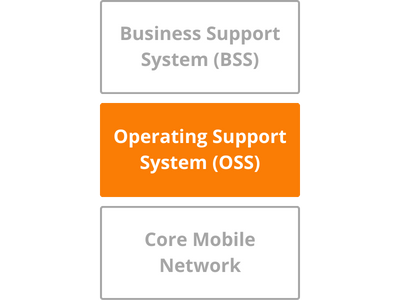
What are the 4 key parts of the Operational Support System (OSS)?
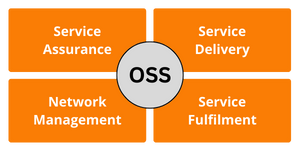
In essence the Operational Support System (OSS) play a pivotal role in the telecommunications and service provider landscape, focusing on the operational aspects of service delivery, network management, and resource optimization. Altogether the OSS encompasses a suite of software applications, tools, and processes designed to ensure the efficient functioning of network infrastructure and the delivery of high-quality services. In this comprehensive exploration, we will dissect OSS into its four primary components, shedding light on their intricacies and significance.
Network Management
- Network Management within the OSS
- What are the key functions of Network Management within the OSS?
- What is the importance of Network Management within the OSS?
- Integration with other OSS Components
Service Fulfilment
- Service Fulfilment within the OSS
- What are the key functions of Service Fulfilment within the OSS?
- What is the importance of Service Fulfilment within the OSS?
- Integration with other OSS Components
Service Assurance
- Service Assurance within the OSS
- What are the key functions of Service Assurance within the OSS?
- What is the importance of Service Assurance within the OSS?
- Integration with other OSS Components
Service Delivery
- Service Delivery within the OSS
- What are the key functions of Resource Management within the OSS?
- What is the importance of Resource Management within the OSS?
- Integration with other OSS Components
Network Management
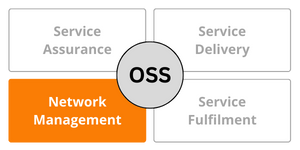
Network Management within the OSS
Clearly Network Management is the cornerstone of OSS, responsible for overseeing the entire network infrastructure, ensuring connectivity, and optimizing resource utilization. In a world increasingly reliant on seamless communication, network management is indispensable for delivering uninterrupted services.
The key functions of Network Management within the OSS
Fault Detection and Diagnosis
These systems are equipped to detect and diagnose network faults, ranging from hardware failures to connectivity issues. Quick fault identification minimizes service disruptions.
Configuration Management
Configuration management maintains records of network device configurations, facilitating easy backup, recovery, and updates. It ensures that network devices are correctly configured.
Inventory Management
Managing network inventory involves keeping track of network assets, such as servers, routers, and cables. Inventory data aids in resource allocation and maintenance planning.
Network Monitoring
Continuously monitoring the performance and health of network elements, such as routers, switches, and servers is all part of the Network management. This real-time monitoring helps identify and address issues promptly.
Performance Optimization
Network management includes mechanisms to optimize network performance, such as load balancing, traffic shaping, and Quality of Service (QoS) management. These techniques ensure consistent service quality.
What is the importance of Network Management within the OSS?
All in all Network Management is the linchpin of reliable service delivery. It ensures network stability, minimizes downtime, and guarantees that services are delivered at the expected quality levels. Efficient network management directly impacts customer satisfaction and helps service providers meet Service Level Agreements (SLAs).
Integration with other Operational Support System (OSS) Components
Generally speaking Network Management interfaces with all other OSS components to provide critical network information. For example, it collaborates with Service Fulfillment to ensure that services are provisioned on a stable network. Next to this it also feeds performance data to Service Assurance, allowing it to monitor and optimize service quality.
Service Fulfillment
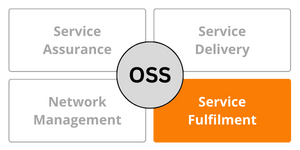
Service Fulfillment within the OSS
In brief Service Fulfillment is the operational arm of OSS, responsible for provisioning customer services, handling customer requests, and ensuring that services are activated correctly. Bridging the gap between customer demand and network capabilities is key.
The key functions of Service Fulfilment within the OSS
Service Provisioning
The systems for Service Fulfillment are responsible for provisioning services requested by customers, whether it’s setting up new connections, activating mobile subscriptions, or configuring broadband services.
Order Management
Customer orders is managed by these systems and they coordinate the end-to-end process. In short they capture order details, track order statuses, and ensure that services are activated according to customer preferences.
Resource Allocation
Optimizing the allocation of network resources to meet customer demands efficiently is part of the Service Fulfillment. As a result the Resource Fulfillment ensures that resources are assigned appropriately to prevent overutilization or underutilization.
Service Activation
After order approval, Service Fulfillment systems trigger service activation processes. This includes configuring network devices, allocating bandwidth, and ensuring that services are accessible to customers.
Activation Testing
To guarantee that services are functioning correctly, Service Fulfillment conducts activation testing to verify that configurations align with customer requirements.
What is the importance of Service Fulfillment within the OSS?
To sum up Service Fulfillment is pivotal for transforming customer requests into operational reality. It ensures that customers receive the services they have subscribed to promptly and accurately. Efficient service fulfillment leads to shorter service activation times and enhanced customer satisfaction.
Integration with other Operational Support System (OSS) Components
For sure Service Fulfillment collaborates closely with Network Management to ensure that network resources are available for service activation. It interfaces with CRM to capture and validate customer orders accurately. Additionally, it coordinates with Billing and Revenue Management to align service activations with billing specifications.
Service Assurance
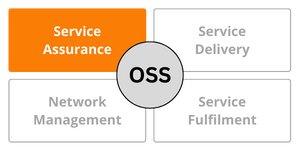
Service Assurance within the OSS
In particular Service Assurance is the guardian of service quality within OSS, responsible for monitoring, analyzing, and optimizing the quality of delivered services. It ensures that services meet customer expectations and comply with Service Level Agreements (SLAs).
The key functions of Service Assurance within the OSS
Fault Management
Detecting, isolating, and addressing faults that may disrupt service quality is all part of the Fault Management. As a result it triggers automated responses or alert operators for manual intervention.
Service Quality Analysis
Conducting in-depth analysis of service quality, including network latency, packet loss, and service uptime is all part of Service Assurance. Which provides insights into areas needing improvement.
SLA Management
Service Assurance systems manage and enforce SLAs with customers and third-party providers. They ensure that service quality meets contractual agreements.
Performance Monitoring
Continuously monitoring the performance of services and network elements is part of the Service Assurance systems. As well as keeping track key performance indicators (KPIs) to ensure that services are meeting quality standards.
Service Reporting
Reporting functionalities generate reports and dashboards that provide insights into service quality and network performance. These reports help in decision-making and optimization efforts.
What is the importance of Service Assurance within the OSS?
Of course Service Assurance is crucial for maintaining service quality and customer satisfaction. By proactively identifying and addressing service issues, it minimizes service disruptions, reduces customer complaints, and upholds the reputation of service providers.
Integration with other Operational Support System (OSS) Components
Collaboration of Service Assurance with Network Management to obtain performance data and with Service Fulfillment to verify that newly provisioned services meet quality standards. It also interfaces with Billing and Revenue Management to ensure that service quality is accurately reflected in billing.
Service Delivery
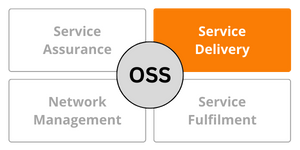
Service Delivery within the OSS
Service Delivery within OSS focuses on the efficient allocation and optimization of network resources, including physical infrastructure, spectrum, and virtual resources. As a result the Service Delivery and resource management play a critical role in ensuring that network resources are used effectively. Overall the Service Delivery is a lot of Resource Management.
The key functions of Resource Management within the OSS
Spectrum Management
In wireless networks, Resource Management manages spectrum allocation and usage to minimize interference and maximize network performance.
Virtual Resource Orchestration
In virtualized and cloud-based networks, Resource Management orchestrates virtual resources, such as virtual machines and containers, to optimize resource utilization.
Network Inventory
Maintaining an inventory of network assets, including physical devices, cables, and virtual resources is part of the Resource Management. It helps in resource tracking and planning.
Resource Allocation
Allocation of network resources based on demand, capacity, and network topology is part of the Resource Management. Therefore it ensures that resources are assigned efficiently to meet service requirements.
Capacity Planning
These systems perform capacity planning to forecast future resource requirements and prevent network congestion. Hence the Capacity Planning helps Mobile Brands / MVNOs scale their networks to accommodate growth.
What is the importance of Resource Management within the OSS?
Overall Resource Management is instrumental in optimizing network efficiency and cost-effectiveness. It ensures that network resources are used judiciously, preventing over-provisioning and resource wastage. Efficient resource management leads to better network performance and reduced operational costs.
Integration with other Operational Support System (OSS) Components
Resource Management interfaces with Network Management to understand network topology and performance requirements. It collaborates with Service Fulfillment to allocate resources for new services. Additionally, it coordinates with Service Assurance to monitor resource utilization and ensure network quality.
The Best Operational Support System (OSS)
On a global scale there are very many OSS solution providers. Each of the solution providers has its own approach, set of applications, modules, and software solutions. Besides this there are also other things you need to think of such as: the level of support, local engagement, customization options. Next to the many different OSS solutions providers it also depends on your needs, requirements, and budget.
In short there is no easy way to state which OSS is the best. For one thing, it depends also on your requirements and needs.
At the same time and in most cases when you select an MVNE/O solution provider you do not have a choice which OSS is to be used. See also: How to select a BSS and OSS
The main difference between BSS and OSS
The main distinctions between OSS and BSS, delving into their unique characteristics, functions, and roles within the telecommunications industry. To put it simply, OSS covers the operations and network side of the Mobile Brand / MVNO, while BSS covers the business and customer side. For more details see: What are the differences between OSS and BSS.
Summary of the Operational Support System (OSS)?
In summary, Operations Support System (OSS) serve as the operational backbone of telecommunications and service providers. The four distinct components of OSS—Network Management, Service Fulfillment, Service Assurance, and Resource Management—work in tandem to deliver seamless services, maintain service quality, and optimize resource utilization. The integration and synergy between these components are crucial for service providers to offer reliable services, enhance customer experiences, and remain competitive in a rapidly evolving landscape.
With OSS as the foundation, service providers can ensure the efficient operation of their networks, drive service quality, and adapt to the dynamic demands of the telecommunications industry.






